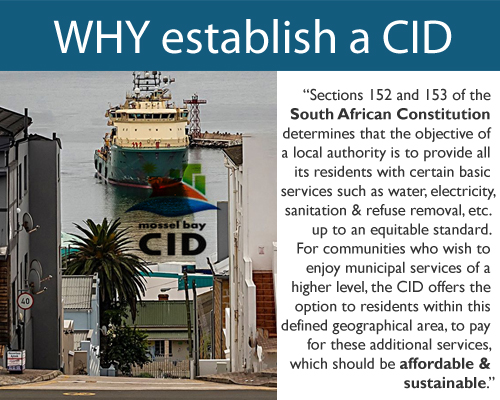What is a City Improvement District?
CID is an acronym for City Improvement District. It is not to be confused with the term CBD (Central Business District). It is a private-public partnership formed and paid by the property owners within a defined geographical area with the purpose to enhance services over and above what the local authority provides. The current CID's geographical area mainly consists of the old CBD, and therefore objectives are aligned accordingly.

Why establish a CID?
Sections 152 and 153 of the South African Constitution determines that the objective of a local authority is to provide all its residents with certain basic services such as water, electricity, sanitation and refuse removal, etc. up to an equitable standard. For communities who wish to enjoy municipal services of a higher level, the CID offers the option to residents within this defined geographical area, to pay for these additional services, which should be affordable and sustainable.


What types of ‘top-up’ services are provided in a CID?
Services include additional public safety measures, cleansing services, maintenance of infrastructure and upgrading of the physical and social environment of the area.
Does the formation of a CID mean that the City can reduce the level and quality of its services?
No - The local authority is obliged to sustain existing service levels and to provide basic services as per the Constitution. The CID will engage with the various service departments of Mossel Bay Municipality regarding the level of services to be provided by them. This will enable the CID to decide on what ‘top-up’ services are required.
What are the benefits for CID members?
By pooling their resources in the CID, individual property owners can enjoy the collective benefits of a well managed area, a shared sense of communal pride, safety and social responsibility. They will also have access to joint initiatives and in the end, these all translate into a tangible boost in property values and capital investments.
Benefits the CID holds for the CBD of Mossel Bay, include:
* A holistic approach towards improvement *
* Enhancement of the environment and strengthening general investor confidence *
* Investment by business *
* Creation of a positive identity for the area *
* Private sector management and accountability *
* Constant measurable effectiveness *
* Monitoring of any new major developments or interventions that impact the area *
* Effective working relationships with appropriate bodies or associations *
* Submission of ideas for change to Mossel Bay Town Council *
How is a CID established?
A CID is initiated by the community and not by the Municipality.
It usually starts with ‘champions’ within a community who feel the necessity to improve the environment within a defined area. They then compile a 5-year business plan (including the motivation report, the implementation plan and a budget) indicating how the improvements are to be achieved, and present this to the community at a public meeting. Thereafter property owners are lobbied for their support where a majority (more than 50% in an area classified as commercial and more than 50% for an area classified as residential) has to give written consent to the formation of a CID.
Once this has been obtained, the steering group has to submit an application to the Municipality. The application is then advertised in the media and property owners are also notified to allow them at least 60 days to render any comments or objections. The Municipality then considers the application in consideration of the objectives.
After the Municipality has approved the application, the CID is set up and a Board is elected. The CID has to register for VAT, open a bank account and be registered as a vendor with the Municipality, etc. This must all be in place before the Municipality pays over the levies to the CID.
Who manages the CID?
The CID is governed by the Companies Act (71 of 2008) and manages its own finances and appoints its own auditors. The audited financial statements form part of the Municipality’s consolidated accounts, which are reviewed by the Auditor-General. In addition, monthly financial reports are submitted to the Municipality to monitor to ensure that expenditure is incurred according to the budget. All CID’s have to submit the Chairperson report and Annual Financial Statements to the relevant Sub-Council within two months of their Annual General Meeting.
How is a CID funded?
The CID is funded from the additional rates paid by its members, calculated on the Municipal value of their properties. It does not receive any subsidies from the Municipality, but does have the powers to raise additional income.
How are the CID additional rates calculated?
The CID management confirms the properties within the boundaries of the CID, which is then linked by the Municipality to the municipal valuations according to the most recent general valuation roll.
The CID management annually prepares an overall budget for the year. This is based on the specific needs of the area as set out in die approved Business Plan. Individual contributions are then calculated by dividing up the budget total according to the municipal valuations of each CID member proportional to the total valuation of the CID.
The CID Policy allows for a differentiation in tariffs for the different types of properties – be it residential, commercial or industrial. This tariff is then expressed as a Rand in the Rand and is applicable over a financial year, which starts on 1 July.
The CID budget and proposed tariff have to e approved by the Municipality and advertised for comments and objections as part of the Municipality’s budget process prior to implementation on 1 July.
How are the CID additional rates collected?
The Municipality collects the additional rates on behalf of the CID. It does not go to the Municipality, although they share an invoice to save on collection costs. The additional rate appears as a separate item (improvement levy) on the monthly municipal account of each property owner liable to pay the CID levy.
What happens to the difference between the actual billing and the pay-over?
The Municipality pays the CID a monthly amount equivalent to one-twelfth of its approved budget less 3% as a provision for bad debts. The provision for bad debts is kept in a ring-fenced account for the CID. At the end of the financial year the Municipality reconciles the billing with the CID budget pay-over and any under or over billing is offset against the accumulated bad debt account. This account is subsequently compared with the arrears as at the end of the financial year. When the latter is less than the accumulated bad debts, 75% of the difference is paid to the CID as per the Finance Agreement concluded between the Municipality and the CID on 12 October 2012.
Is the payment of the additional rates mandatory for all properties within the CID?
Yes – Once the Municipality has approved the CID, the participation of all property owners liable to pay the Special Rating Area levy within the boundaries of the CID is mandatory. However, there are exceptions in terms of relief.
Who can be exempted from paying the CID additional rate?
The following categories of owners/properties will be 100% exempted as per the Special Rating Policy (Mossel Bay Special By-Law dated 5 July 2010):
* Indigent, Senior Citizens and Disabled persons who meet the criteria for rates relief *
* Properties registered in the name of and used primarily as a place of worship *
* Council owned properties used predominantly for official municipal business *
How does the CID set its budget?
The CID sets its own budget according to input from its members as per the approved 5-year Business Plan. The Municipality does not get involved in this process. Each year, the CID Board has to submit a detailed budget to the Municipality by 31 January. The proposed budget may not deviate materially from the approved Business Plan. If there is a material deviation, an application in terms of Section 11 of the Special Rating By-Law is required. The Municipality evaluates the proposed budget for affordability and sustainability.
What if the valuation base changes within a financial year?
The valuation base is a snapshot at a point in time (end February) and is used to calculate the additional rate (rand-in-the-rand) for the following financial year. However, Municipal evaluations can change within a financial year due to interim valuations, Valuation Court rulings, sub-divisions, rezoning or other technical adjustments. Should the valuation base decrease or increase substantially, the Municipality must inform the CID in order to recalculate the Special Rating Area’s additional rates.
Can my CID additional rates be spent anywhere in the Municipality?
No – it is ring-fenced to be ploughed back exclusively into the CID.
How does the Municipality resolve additional rates arrears?
Defaulters are subject to the Municipality’s credit control and debt collection policies. As such, they can have their water and electricity services suspended or their rates clearance certificates withheld.
Do members have a say in the CID?
Yes – every property owner within the CID should apply in writing to the CID Board for membership. Once the Board has approved this application, the member will be able to participate in CID affairs.
Board of Directors
Get to know the team of Directors who ensures total transparancy & accountability on the core objectives & goals of the Mossel Bay CID.